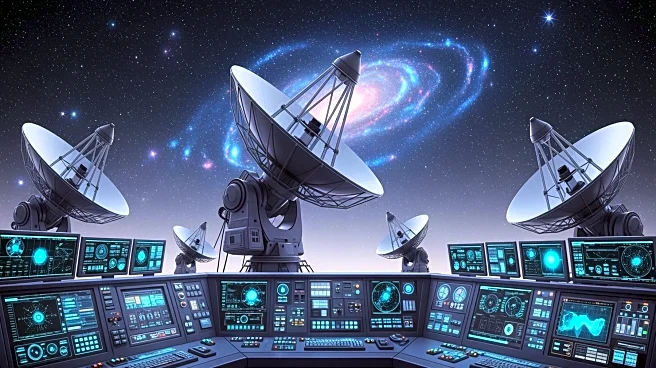What's Happening?
Astronomers have made significant progress in detecting a faint radio signal from the early universe, known as the 21-centimeter hydrogen line. This signal, which dates back to approximately 800 million
years after the Big Bang, could reveal properties of primordial stars and black holes that played a role in reionizing the cosmos. The study, conducted by researchers including Ridhima Nunhokee from the International Centre for Radio Astronomy Research, utilized data from the Murchison Widefield Array in Western Australia. The team developed a new statistical filtering technique to isolate the signal from layers of stronger radio noise originating from the Milky Way, nearby galaxies, Earth's atmosphere, and the telescope itself. Despite the challenges, this approach has produced the cleanest radio map of the early universe to date, setting stringent limits on the strength of the 21-centimeter signal.
Why It's Important?
The ability to detect the 21-centimeter hydrogen line is crucial for understanding the universe's transition from the 'cosmic dark ages' to the Epoch of Reionization, when the first stars and galaxies began to emit light. This research provides insights into the temperature and environment of intergalactic hydrogen gas during this transformative period. By ruling out a 'cold start' to reionization, the findings suggest that the universe was warmer than previously expected, likely due to X-rays from early black holes and remnants of massive stars. This knowledge is vital for refining cosmological models and understanding the processes that shaped the universe's evolution.
What's Next?
The new data-cleaning technique lays the groundwork for future observations with the Square Kilometre Array (SKA), a next-generation radio telescope currently under construction in Australia and South Africa. The SKA is expected to have the sensitivity required to directly detect the elusive 21-centimeter signal, providing further insights into the early universe. Researchers anticipate that a few hours of SKA data will allow them to reach the desired levels of detection, advancing our understanding of the universe's formative years.
Beyond the Headlines
The study highlights the challenges of detecting ancient cosmic signals buried beneath layers of radio noise. The development of advanced filtering techniques not only aids in isolating these signals but also enhances the capabilities of existing and future radio telescopes. This research underscores the importance of technological innovation in astronomy, paving the way for deeper exploration of the universe's origins and the conditions that led to the formation of stars and galaxies.













